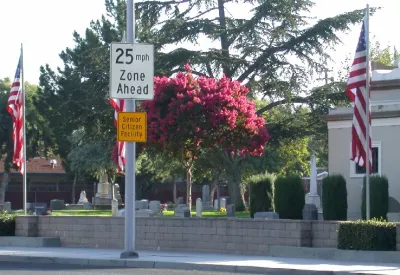A call to action to change the paradigm of planning and development to better serve an aging nation.

Allison Arieff takes a detailed and compassionate look at the housing implications of the country's aging population.
The article begins with a personal anecdote—if this issue isn't personal to you yet, as it is for Arieff, than it will be soon enough. The population aged 65 and over is expected to grow to 79 million from 48 million in the next 20 years. Most communities in the country are not prepared to accommodate the demographic explosion.
Arieff first cites a new report from the Joint Center for Housing Studies at Harvard [pdf], "Projects and Implications for a Growing Population: Older Households 2015-2035 Housing," which "reveals that this demographic shift will increase the need for affordable, safe housing that is well connected to services way beyond what current supply can meet." Supplementing those demographic realities are the facts about where the country is growing, as presented by findings of a new study from the Urban Land Institute's Terwilliger Center for Housing. That study "shows that suburban areas surrounding the 50 largest metropolitan areas in the United States make up 79 percent of the population of those areas but accounted for 91 percent of population growth over the past 15 years (and three-quarters of people age 25 to 34 in these metro areas live in suburbs)."
Thus, Arieff illustrates how decades of development and settlement patterns have left so much of the country's aging population in communities that don't serve their needs.
But suburban homes were originally designed, and for the most part still are, for young families — and for drivers. They are typically surrounded by other single-family houses. Lacking a fitter partner or a network of helpful neighbors and caring family members, older residents can end up feeling isolated, unable to do basic errands or keep up their property.
Then, a call to action: "We’ve got to change this paradigm." More specifically, Arieff argues that urban environments, with their proximity, transit, and density, shouldn't be the only option for seniors, and she has suggestions for how suburban communities can also build a better quality of life for seniors.
FULL STORY: A Housing Crisis for Seniors

National Parks Layoffs Will Cause Communities to Lose Billions
Thousands of essential park workers were laid off this week, just before the busy spring break season.

Retro-silient?: America’s First “Eco-burb,” The Woodlands Turns 50
A master-planned community north of Houston offers lessons on green infrastructure and resilient design, but falls short of its founder’s lofty affordability and walkability goals.

Delivering for America Plan Will Downgrade Mail Service in at Least 49.5 Percent of Zip Codes
Republican and Democrat lawmakers criticize the plan for its disproportionate negative impact on rural communities.

Test News Post 1
This is a summary

Test News Headline 46
Test for the image on the front page.

Balancing Bombs and Butterflies: How the National Guard Protects a Rare Species
The National Guard at Fort Indiantown Gap uses GIS technology and land management strategies to balance military training with conservation efforts, ensuring the survival of the rare eastern regal fritillary butterfly.
Urban Design for Planners 1: Software Tools
This six-course series explores essential urban design concepts using open source software and equips planners with the tools they need to participate fully in the urban design process.
Planning for Universal Design
Learn the tools for implementing Universal Design in planning regulations.
EMC Planning Group, Inc.
Planetizen
Planetizen
Mpact (formerly Rail~Volution)
Great Falls Development Authority, Inc.
HUDs Office of Policy Development and Research
NYU Wagner Graduate School of Public Service




























